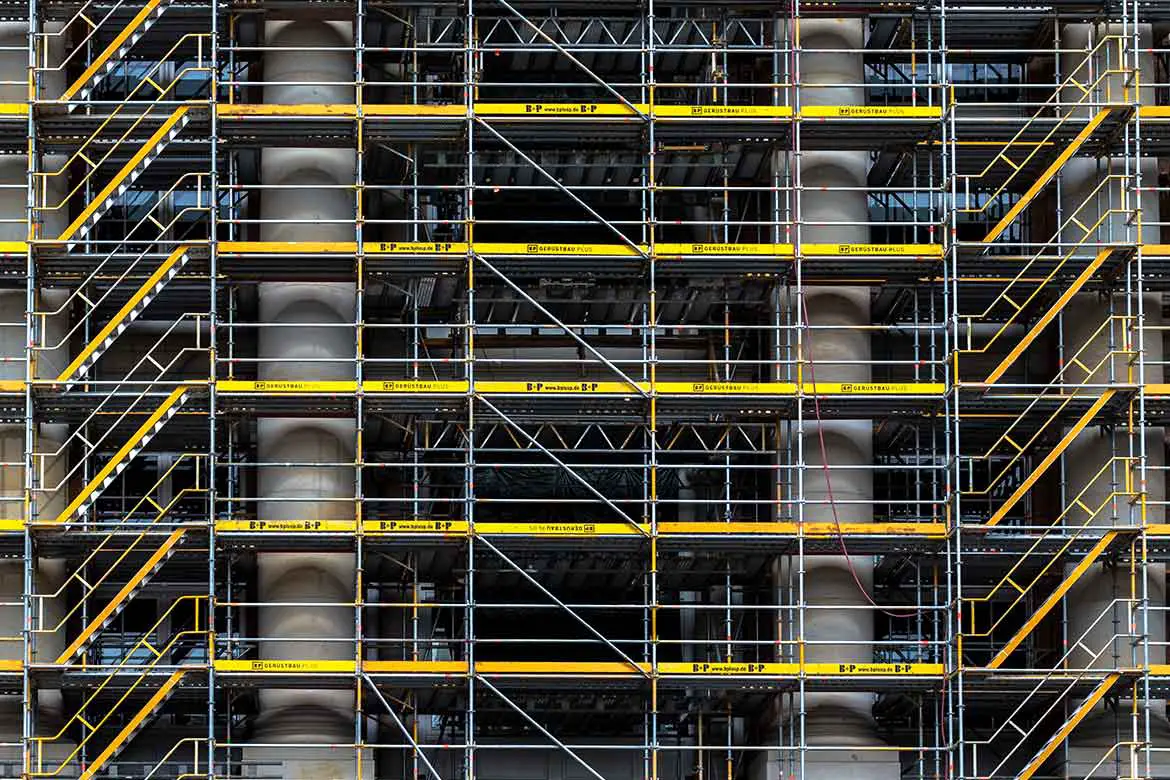Construction workers generally need support equipment to reach the upper parts of the buildings. This equipment is scaffolding, which is considered safe for raising the workers to the required heights. Scaffolding is available in various sizes and shapes, with the most common ones being foldable and rectangular. It may be bought or rented.
What is Scaffolding?
Scaffolding in construction usually means temporary structures that access all building parts under construction, reconstruction, or restoration. However, scaffolding is also used as a supplement to formwork systems, where they take over the loads that need to be transferred to solid supports in the shortest possible way.
To estimate the amount of scaffolding needed for a particular project, you must evaluate the type and size.

Scaffolding refers to a temporary structure or framework erected to provide support and a platform for workers during construction, maintenance, or repair work on a building or other structure. Scaffolding is typically made of metal pipes or tubes and consists of various components, including vertical poles, horizontal poles, diagonal braces, and planks or platforms.
Scaffolding provides a safe and stable working platform for workers to perform tasks at different heights and locations. Scaffolding is an essential component of many construction projects and must be erected and used in compliance with safety regulations to ensure the safety of workers and the public.
How do You Calculate Scaffolding Quantity?
Given below are the precise steps to figure out how to calculate scaffolding materials – scaffolding quantity :
- Determine the total area that needs to be covered by the scaffolding. This can be done by measuring the length and height of the project area and multiplying the two values together.
- Determine the height of the scaffolding needed. This will depend on the height of the project area, the maximum height of the scaffolding available, and any regulations that need to be followed.
- Calculate the number of bays needed. A bay is a distance between two vertical scaffold poles. Divide the total length of the project area by the width of each bay to determine the number of bays needed.
- Calculate the total number of vertical poles needed. Multiply the number of bays by the number of vertical bars needed per bay.
- Calculate the total number of horizontal poles needed. Multiply the number of bays by the number of horizontal poles needed per bay.
- Determine the number of diagonal braces needed. This will depend on the height of the scaffolding and the regulations that must be followed.
- Calculate the number of planks needed. Multiply the number of bays by the number of planks required per bay.
- Add up the total number of vertical poles, horizontal poles, diagonal braces, and planks needed to determine the total quantity of scaffolding required for the project.
Note: It is essential also to consider any additional materials needed, such as base plates and couplers, and to ensure that the scaffolding is constructed and used in compliance with safety regulations.
Once you have determined the scaffolding quantity, you may also estimate the daily rental expenses. It would help if you multiplied per-day costs and the total count of scaffolding sections for this. Further, suppose your project is expected to be completed within a specific time. In that case, you can calculate the total cost of scaffolding by multiplying the per-day cost by the whole workday.
Calculate scaffolding quantity Example.
Calculating the quantity of scaffolding needed for a project involves several factors, such as the size and height of the structure, the type of scaffolding required, and the spacing between each scaffold.
Let’s consider a simple example:
Suppose we need to construct a brick wall that is 10 meters long and 3 meters high. We plan to use frame scaffolding consisting of vertical frames, cross braces, and planks, with a spacing between each scaffold of 2 meters.
To calculate the quantity of scaffolding required, we can follow these steps:
Step 1: Calculate the total area of the wall to be constructed.
Area of the wall = Length x Height Area of the wall = 10m x 3m = 30m²
Step 2: Calculate the number of scaffolds required.
We must divide the wall length by the spacing between each scaffold to determine the number of scaffolds needed.
Number of scaffolds = Length of wall / Spacing between each scaffold Number of scaffolds = 10m / 2m = 5 scaffolds
Step 3: Calculate the total length of planks required.
Each scaffold requires two planks, so we must multiply the total number of scaffolds by two.
Total length of planks = Number of scaffolds x 2 Total length of planks = 5 scaffolds x 2 = 10 planks
Therefore, we need five frame scaffolds and ten planks to construct a brick wall that is 10 meters long and 3 meters high with a spacing of 2 meters between each scaffold.





